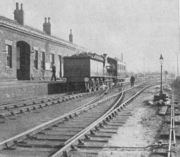Pumping Station, Whitacre Waterworks
Brick in Shustoke, EnglandThe Pumping Station at Whitacre Waterworks, Shustoke, Warwickshire, is a Victorian Civic Gospel pumping house built in circa 1872. Along with the construction of Shustoke Reservoir, it was originally designed to pump six million gallons of fresh water per day to nearby Birmingham. It started operating in 1883, but was shortly thereafter in 1904 put into standby as the Elan Valley reservoirs and aqueduct scheme started to supply Birmingham with its freshwater needs. It instead was latterly used in 1908 to supply water to Coventry, and now Nuneaton, Atherstone, and Bedworth. The water supply emanates from the nearby river Bourne and the river Blythe. The pumping station building was listed grade II* in March 1982 as a notable example of civic gospel. The listing also covers a Victorian filter house, water well, and Superintendent's house. In 2018 the unused building was placed on Historic England's Heritage at Risk Register due to its poor condition and prioritised as in immediate risk of further rapid deterioration.





